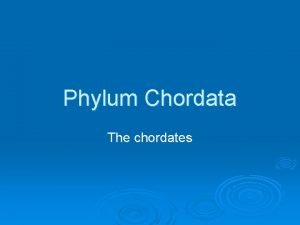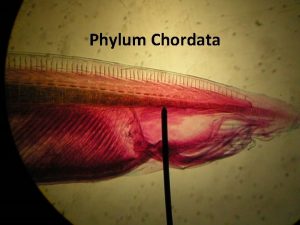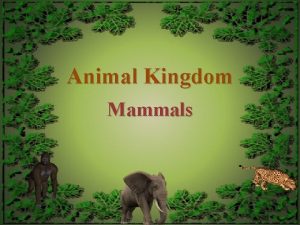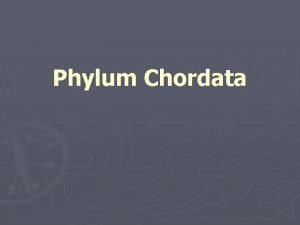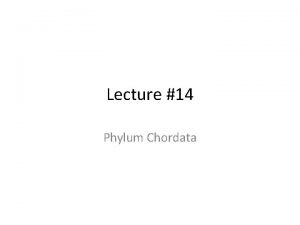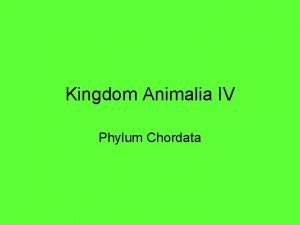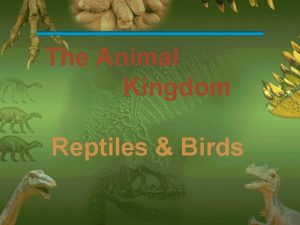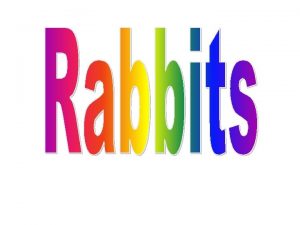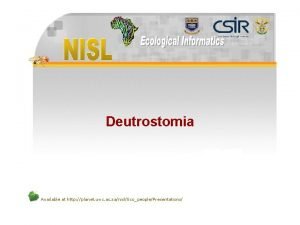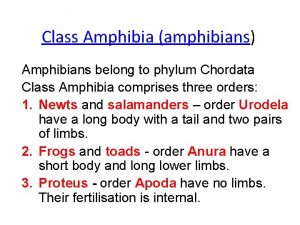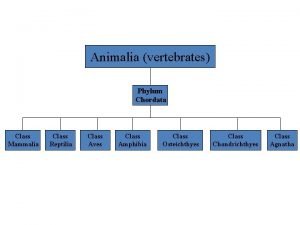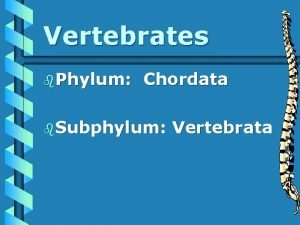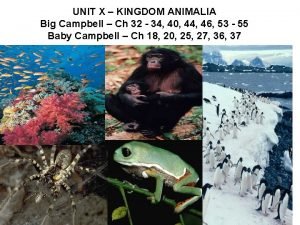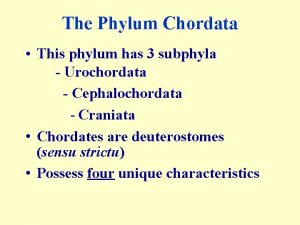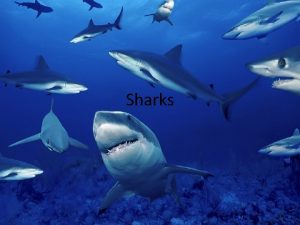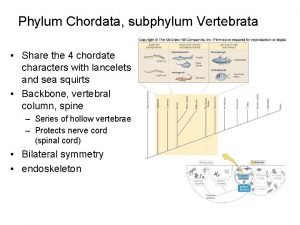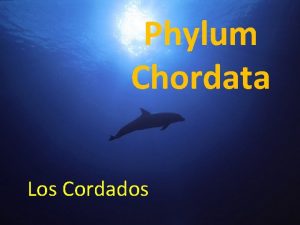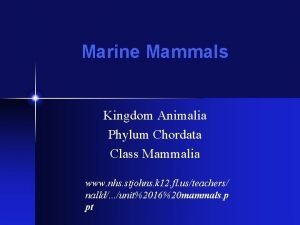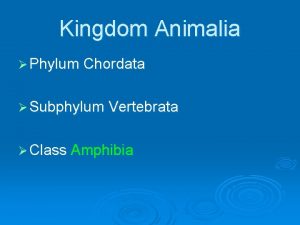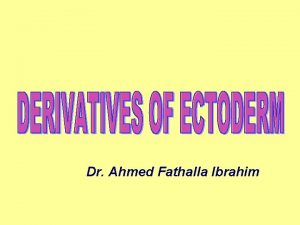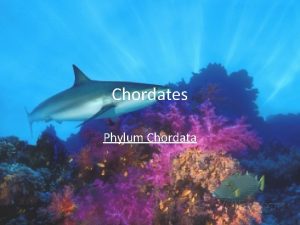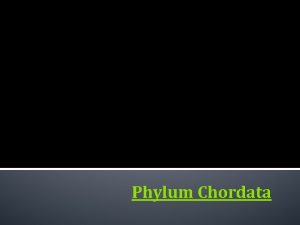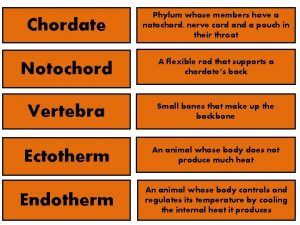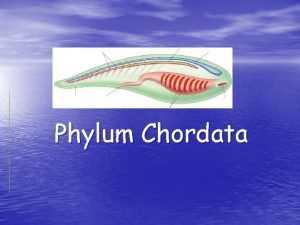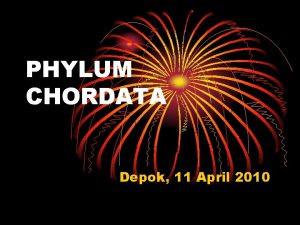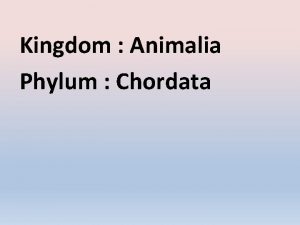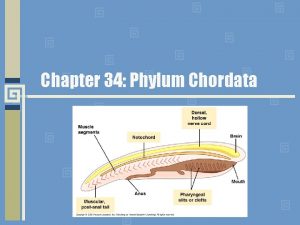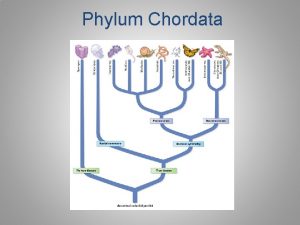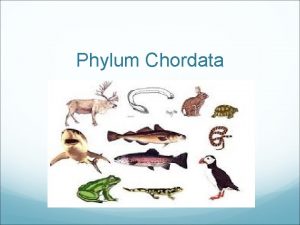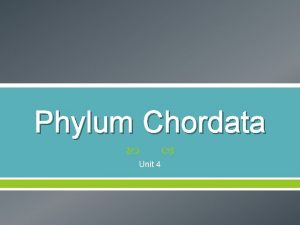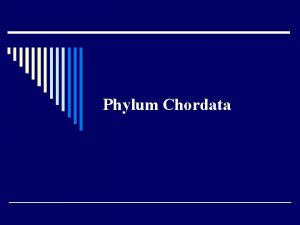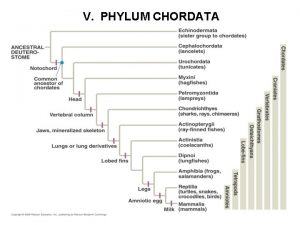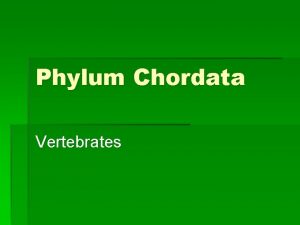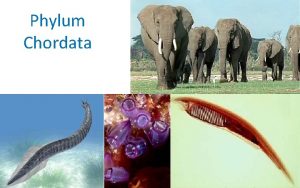Phylum Chordata Chordate animals that have a notochord



















- Slides: 19

Phylum Chordata

Chordate: animals that have a notochord in the embryonic form

Notochord: a flexible rod that extends the length of the body Notochord

4 Characteristics of Chordates 1. Dorsal nerve cord 2. Notochord 3. Pharyngeal gill slits 4. Tail

Subphylum Vertebrata: animals whose dorsal nerve cord is protected by a series of bone

Characteristics 1. Endoskeleton 2. Skull and Backbone 4. Vertebrae that encloses/protects the nerve cord 3. Hinged Jaw

Fish: most primitive vertebrates

Ichthyology: study of fish -first jawed vertebrates -evolved during the Devonian Period (350 MYA) -fins/scaled/gills -two chambered heart with a closed circulatory system

Fish Heart 1. Atrium: a chamber that holds blood before pumping it into the ventricle 2. Ventricle: muscle chamber responsible for pumping blood throughout the body

Fish external anatomy

Fish Taxonomy Fish Class Agnatha (jawless) Class Chondrichthyes (cartilagenous) Class Osteichthyes (bony)

Class Agnatha: “no jaws” -circular mouth with teeth -freshwater parasites -elongated bodies Ex. Lamprey

Class Chondrichthyes: sharks and rays -cartilage skeletons -lack gill cover -detect electric fields from muscle contractions -swim to keep from sinking Ex. Nurse shark, sand skate

Class Osteichthyes: bony fish -ossified (boney) skeleton -operculum: protective gill cover -skin glands that secrete slimy covering Ex. Box fish, walleye, largemouth bass, porcupine puffer, piranha, black molly, catfish

Class Amphibia: “double life” Introduction: -linked to water for reproduction -evolved in the Carboniferous period -ecosystem was all wetlands

Class Amphibia: “double life” Characteristics: -aquatic larval stage with gills (tadpoles) -four legs - tetrapods -herbivores as larva; carnivores as adults -respiration with lungs and through skin -external ear drums -three chambered heart

Specimens -grass frog (Rana pipiens) -bull frog -american toad -red-spotted newt -red eyed tree frog -African clawed frog -poison dart frogs

Class Reptilia • First terrestrial quadriped • Amniotic egg (oviparous reproduction) -body covered with scales -breath entirely with lungs - “ 3. 5” chambered heart

Specimens - King snake Ball python Reticulated python Water mocassin Snapping turtle Map turtle Leatherback sea turtle Eastern painted turtle - Anole - American alligator
 Chordates phylum
Chordates phylum Notochord animal
Notochord animal Playtpuses
Playtpuses Common characteristics of chordates
Common characteristics of chordates Is phylum chordata a vertebrate
Is phylum chordata a vertebrate What are chordata
What are chordata Reptiles order
Reptiles order Family leporidae kingdom
Family leporidae kingdom Characteristics of bony fish
Characteristics of bony fish Phylum chordata class amphibia
Phylum chordata class amphibia Aves kingdom
Aves kingdom Phylum chordata class reptilia
Phylum chordata class reptilia Chordata subphylum vertebrata
Chordata subphylum vertebrata Body covering of animals
Body covering of animals Phylum chordata
Phylum chordata What phylum are sharks in
What phylum are sharks in Digestive system of chordata
Digestive system of chordata Phylum cordados
Phylum cordados Seal phylum
Seal phylum Phylum
Phylum
